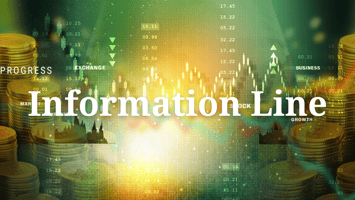|
Perspective
By Rich Checkan
We just finished another successful Investment U conference in Ponte Vedra Beach, Florida… their 27th annual event.
Last year at this conference, we had just breached $2,200 per ounce for gold. And everyone told me that gold, at all-time highs, was too expensive. They all wanted to wait for the pullback to buy some gold.
My message was just the opposite. Gold, at all-time highs, was dirt cheap. I was convinced it was going higher because all the buying to date had come primarily from central banks.
Investors were not yet in the market as we met last February in Ojai, California.
Since then, gold registered 39 new all-time highs in 2024. Thus far in 2025, gold has reached 16 more new all-time highs.
As I addressed the Investment U crowd this year, gold was trading over $3,100 per ounce. As you can imagine, the general consensus was that gold was too expensive, and they wanted to wait for the pullback to buy.
Again, my view is the exact opposite. The buying is still primarily coming from central banks. In fact, central banks have bought over 1,000 tons of gold each of the past three years. That’s a full 40% to 60% higher than any of the previous twelve years… all of which saw net central bank gold buying.
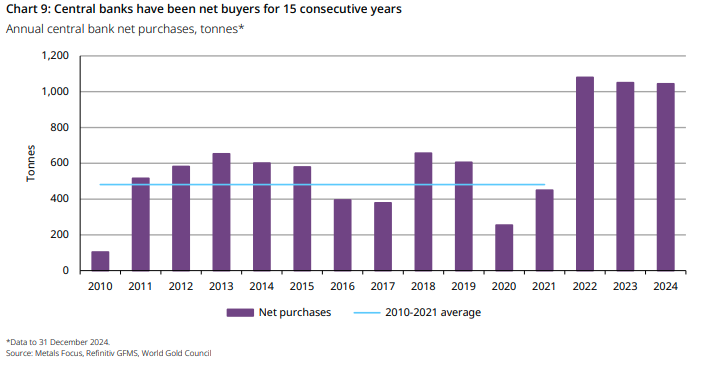
And still… the Western investors are largely absent from this market.
We know this for two reasons…
First, the Gold/Silver Ratio (GSR) has been stuck at 90 for two to three years now. That means it is taking 90 ounces of silver to buy one ounce of gold.
Typically, as a precious metals bull market matures, investors buy both gold and silver. Since silver is a smaller capitalized market, the impact on the silver price is greater than the impact on the gold price. It is like tossing a stone into a puddle (silver market) versus a pond (gold market). The splash is proportionally larger in the silver market.
This leads to the silver price rising faster than the gold price. That results in the GSR falling.
BUT… that is not happening now. Gold is making new all-time highs. Silver is lagging behind. The GSR is stuck in the mud at 90.
That is because central banks do not buy silver. They buy gold. And that is really all that is being bought right now.
The second reason we know the Western investor is not in this market in a meaningful way is due to premiums. They are at some of the lowest levels I have seen in my thirty years in the industry.
If investors were clamoring to buy fabricated gold and silver bars, the premiums charged by the mints, refiners, and wholesalers would skyrocket. Prices for fabricated products would be through the roof.
They are not.
Investors have yet to awaken to this gold and silver bull market.
That is why I believe we have quite a bit of room to the upside. I cannot believe this bull market will end without the participation of the Western investor. I do believe holding above $3,000 on the gold price is just what is needed to bring investors into this trade.
This psychological level is quite possibly the proverbial straw that will break the camel’s bank.
Time will tell, but I pray I do not show up next year at this conference telling people they should have bought before gold broke through $4,000 per ounce.
Got Gold?!?!
Need More Information?
Do not just take my word for it.
I recently had a brief conversation with Alasdair MacLeod of MacLeod Finance. We talked about the various factors pushing the gold price higher.
I encourage you to watch this short, roughly twenty-minute video Q&A.
We have known Alasdair for many years, and we respect his insights built upon decades spent following financial markets and precious metals in particular over the past decade and a half.
In addition, next Monday (April 7th), I will be joining Avi Gilburt of Elliott Wave Trader, for a discussion about the precious metals markets as well as tips into how best to hold precious metals in this current economy.
We will get going shortly after the markets close next Monday. You can join us by registering here.
Avi’s track record in predicting peaks and valleys in various markets is well-documented.
I am absolutely looking forward to our conversation, and I do hope you will join us.
In the meantime, let us help you Keep What’s Yours!
Remember… dips are opportunities to buy well.
And when you buy, we have a great deal for you to store cost-effectively. Spend $10,000 or more through us and store with our friends at International Depository Services (IDS) between now and June 30th, 2025, and you will receive free storage through the end of 2025!
Call us at 1-800-831-0007 to start your free storage today!
Visit our online store. Send us an email. Call us toll free at (800) 831-0007.
We stand ready to help.
—Rich Checkan
Editor's Note: Frank Holmes is the CEO of U.S. Global Investors —a company that produces quality analysis concerning gold, precious metals, natural resources, and emerging markets—in conjunction with his work as a fund manager. Frank is a long-time friend of ours, and we've chosen to share his article originally published March 17, 2025. For more articles like this from Frank and other leading experts, you can subscribe to the U.S. Global Investors newsletter here.
Feature
Recession Warning Signs Are Flashing Red as Consumer Confidence Collapses
By Frank Holmes
Investors are scrambling to make sense of the on-again, off-again nature of President Donald Trump’s tariffs, the Federal Reserve’s next moves and the broader geopolitical uncertainty gripping the world.
The S&P 500 has entered its first correction since October 2023, dropping 10% from its recent high. Meanwhile, gold prices have surged to record levels, topping $3,000 per ounce for the first time ever.
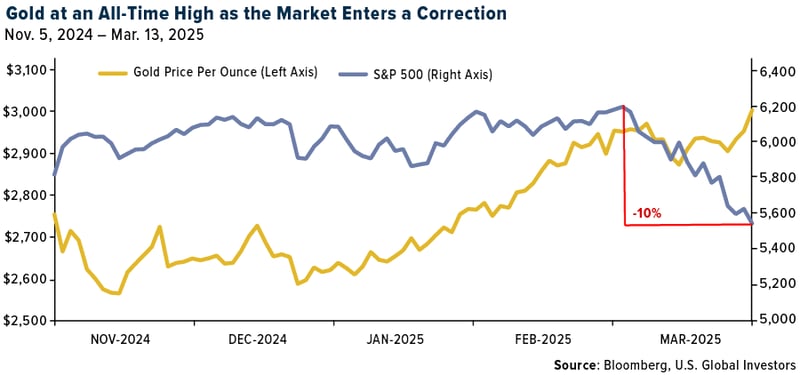
The headlines scream “Recession!” one day and “Strong labor market!” the next. With so much noise, how should investors respond?
Tariffs, Uncertainty and Mixed Economic Signals
Trade policy uncertainty is one of the biggest forces driving markets right now. One day, Trump imposes new tariffs on Canada, Mexico and China, sending markets lower. The next day, he scales them back.
This kind of back-and-forth makes it difficult for businesses to plan, as a recent CEO survey suggests. Looking ahead 12 months in the future, CEOs’ business optimism fell to 4.99 this month, a 28% decline from January and the lowest recorded level since the spring of 2020, when the pandemic shut down the global economy.
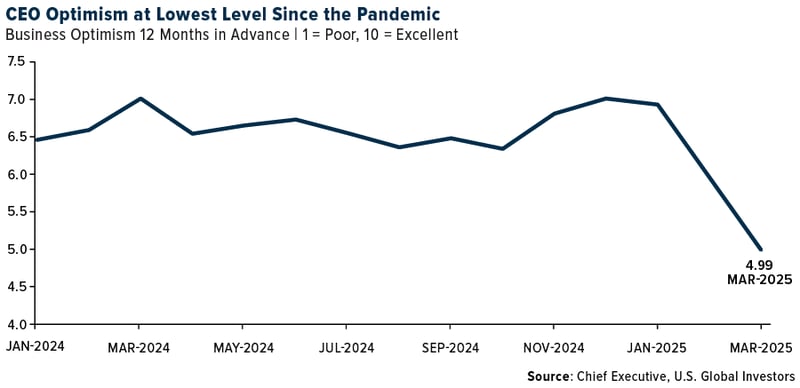
It’s not just tariffs, though. Recent economic data has been all over the map. Consumer confidence sank this month to the lowest level since November 2022, according to University of Michigan data. Retail sales slowed in February, construction spending dipped and manufacturing activity declined. Yet the labor market remains strong, with historically low unemployment and rising wages.
Some economists are convinced a recession is around the corner. The Atlanta Fed’s GDPNow model, for instance, forecasts that the U.S. economy will shrink by 2.4% in the first quarter.
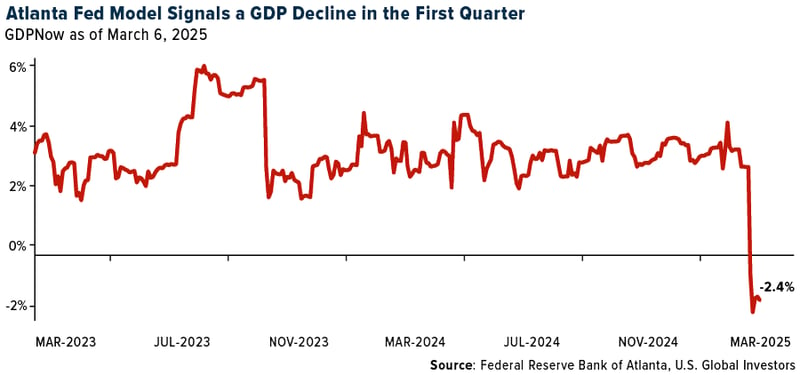
Meanwhile, PIMCO sees a 35% chance of a U.S. recession in 2025, up from just 15% last December. JPMorgan puts the odds at 40%, warning that Trump’s trade policies could damage America’s standing as a global investment destination.
On the other hand, some analysts argue that fears of a downturn are overblown. For instance, FactSet reports that fewer S&P 500 companies mentioned “recession” in their latest earnings calls than at any time since early 2018.
Confused yet?
The Smart Investor Cuts Through the Noise
When faced with mixed messages, it’s easy to get caught up in short-term market swings. But history teaches us that corrections are a normal part of investing. Markets don’t move in a straight line, and downturns often present buying opportunities for those who stay level-headed.
Take a look at hedge funds. Some of the recent market weakness may not even be about the economy but rather the actions of quant-driven hedge funds. According to JPMorgan strategist Nikolaus Panigirtzoglou, equity quant and telecommunications sector hedge funds aggressively cut their equity exposure in February, driving selling pressure in the market. That’s not a fundamental problem—it’s a technical one. Markets can swing in the short term for all kinds of reasons that have nothing to do with the real economy.
And let’s not forget the Fed. Inflation may still be a concern, but many investors expect the central bank to cut rates later this year. Historically, rate cuts are good for stocks and great for gold.
Why I Believe Gold Belongs in Your Portfolio
At times like this, I always return to one of my core investing principles: the 10% Golden Rule. I recommend investors keep 10% of their portfolio in gold—5% in physical gold (bars, coins, jewelry) and 5% in high-quality gold mining stocks or ETFs. I’ve found that this strategy has provided both stability and upside potential in volatile markets.
Gold’s been on a tear, hitting record highs. Why? Because it thrives in uncertainty. When investors don’t know what to believe—when markets correct, inflation worries persist and geopolitical risks escalate—gold has tended to shine. Central banks around the world are snapping up gold at an unprecedented pace, a clear sign that major institutions see it as a store of value amid economic turbulence.
Gold mining stocks, meanwhile, offer leverage to gold prices, as I told Fox Business’s Liz Claman last week. While the metal itself has climbed, many gold miners remain undervalued compared to historical trends. I believe this presents an attractive opportunity for investors looking to gain exposure to gold’s upside.
Stick to Your Long-Term Goals
If you’ve been in the markets long enough, you know that corrections come and go. The S&P 500 has experienced dozens of them over the years, and yet it continues to hit new highs over time. Panicking and making emotional investment decisions is one of the biggest mistakes an investor can make.
The same applies to gold. If you don’t already have an allocation, I believe now is a good time to start building one. Stay the course and consider using market dips to add to your position.
As investors, our job is not to predict the next move in the market—it’s to build a resilient portfolio that can weather any storm. That means cutting through the noise, focusing on long-term trends and making sure you have exposure to real assets like gold that have a history of providing a hedge against uncertainty.
Editor's Note: Omar Ayales is the Senior Trading Strategist & Editor at GCRU (Gold Charts R Us). If you have any questions, you can reach him at oayales@adenforecast.com or visit www.goldchartsrus.net.
Hard Stuff
Gold's Time to Shine
By Omar Ayales
After a fantastic 2024, the gold market continues to shine among global assets, rising strong in the first quarter and positioned to finish the year even higher.
With each passing day, gold demand continues to grow, especially among big players like global central banks and, in many cases, in exchange for their U.S. dollar holdings. It could end up being the trade of the decade: sell the U.S. dollar and buy gold.
But this didn’t just happen overnight.
A combination of factors has contributed to a shift in global perception. These include the gross devaluation of the U.S. dollar’s purchasing power and the sudden emergence of a viable alternative.
The past 25 years have seen the U.S. and almost every other sovereign with a currency worldwide increase their monetary base without backing. Capital and foreign exchange controls have been common in many countries to create false expectations.
One of the assets central banks worldwide own that allows for the substance and backing of the currency they issue is U.S. dollar or U.S. treasury holdings. Others, too, are held in smaller quantities given the risk of liquidity, unlike the U.S. treasury market, which boasts of being the most liquid in the world.
However, in 2019, the Bank of International Settlements (BIS), a sort of central bank for central banks regarding monetary policy and industry practices worldwide, changed the rules of the game. Back then, they reclassified gold, providing it “Tier 1” status, which allows global central banks to own it as a reserve in a way that could even contribute to more favorable reviews from rating agencies.
It should be no surprise that central banks globally have increased their purchases of gold since then. The most notable has been the past three years (2024, 2023, and 2022), when central banks combined added more than 1,000 tonnes during each of those years, according to the World Gold Council.
Consider that global central banks picked up the pace of purchases during the Biden administration after the U.S.’s response to Russia’s invasion of Ukraine. The U.S. chose to weaponize the U.S. dollar in response which was not seen favorably by financial authorities.
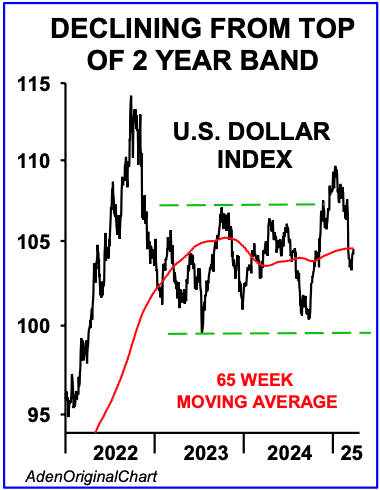
Now, the Trump administration in the U.S. is changing more norms and it’s creating lots of uncertainty globally. It’s pushing monetary authorities outside the U.S. to double down on the “sell the dollar buy gold trade.”
Interestingly, a weaker dollar due to global sell off might play right into Trump’s agenda. A cheaper dollar is exactly what Trump needs to complete his plan of bringing manufacturing back to the U.S. to turn the. U.S. into an export economy.
Regardless, it seems there are many forces trying to drive the U.S. dollar lower. Forces that could be forging a new trend of a lower U.S. dollar for the foreseeable future, a situation that could be very bullish for gold and global currencies.
Timing the Market
It’s anyone’s guess where gold will be and when at its next critical peak.
But consider that a rise to $4,000 over the next year, would be equal to the rise gold had during the last secular bull market that began in 2001 and ran thru 2011-12.
Consider the current secular bull market began in 2015-16, after a gruesome but relatively short bear market in gold from the 2011-12 peak to the 2015 trough. The cycle tends to last 11 years and could be peaking over the next year.
Moreover, consider bull markets usually end with a bang. A manic phase where the retail market jumps in and price goes parabolic. We have not yet enterred into that phase.
A key indication is price action of the gold miners. Although they have been rising, they’re poised to rise higher, to outperform gold, which tends to happen when gold shows strong price action. Moreover, usually western buyers buy gold through the miners, telling us that there’s still lots of cash on the sidelines, possibly looking to buy in.
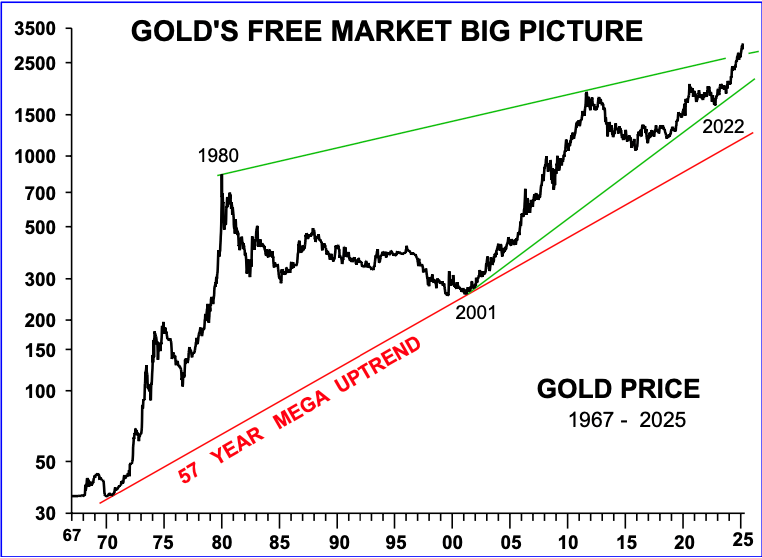
Although the rise to date has been nothing short of spectacular, it still has room to rise. Don’t be surprised if gold rises to $4,000 by the end of the year.
Even more importantly will be price action in silver and the gold miners. If both assets, which tend to move on gold’s dynamism continue to rise, above key resistance levels, then it would confirm gold’s move up. But if silver and the miners start to lag, it could be a sign gold’s move could be coming to an end. Keep a close eye on $35 for silver and 360 on the HUI Index. If both break above these levels, meaningfully, we could see stronger upside potential.
Editor's Note: ASI Co-Founder Michael Checkan would like to direct your attention to the potential of international real estate investment with our friends Mike Cobb and Joel Nagel at ECI Development.
The Inside Story
I Thought I Was in the Wrong Place!
By Michael Checkan
When I recently stepped back onto the grounds of Gran Pacifica, I was overwhelmed by the transformation over the past two decades. When I visited in 2003 with my friend Claude, we got stuck in 18 inches of mud just trying to get there. Now this ambitious dream by Mike Cobb and Joel Nagel is a vibrant, thriving community with stunning beaches and world-class amenities. And oh yes. A paved road to get there.
I was excited to return to Gran Pacifica. I remembered a cattle pasture, raw land with no infrastructure and only a partial outline of what it could become. I recall thinking about the challenges ahead for my friends to bring this dream to life. Today, that vision has been fully realized, and what exists now is nothing short of remarkable.
The Evolution of a Dream
From the outset, Gran Pacifica was conceived as more than just a real estate development; it was designed to be a neighborhood of like-minded individuals. The commitment to planning and execution has been evident every step of the way. The community now boasts fiber optic internet, luxury homes, condominiums, and an impressive nine-hole golf course. More importantly, it offers a range of living options tailored to different needs and budgets, making it accessible to a wide variety of residents.
The key aspect that struck me on this visit was the hospitality and the true sense of community. I had the pleasure of dining with residents like Grant and Sasha, who shared their experiences of living and working remotely from Nicaragua. Their stories reinforced an essential truth: in today’s world, you can build a thriving career while enjoying the tranquility of a beachside paradise.
Beyond Real Estate: A Commitment to Community
What makes Gran Pacifica stand out beyond its physical development is its dedication to improving the surrounding region. A prime example of this is the Roberto Clemente Clinic initiative. You may have read my article last month about the clinic at Rancho Santana. Gran Pacifica, along with the Pittsburgh Rotary built the 3rd such clinic in Nicaragua serving the nearby population with essential medical care.
To give long-term sustainability to the clinic, Mike and Joel have proposed a rotational doctor program. Doctors would volunteer for a week or two, providing medical care to local residents while also offering paid services to expatriates and visitors. In return, they and their families would enjoy a tremendous oceanside vacation in Nicaragua. This approach not only ensures high-quality medical care for all but also helps maintain financial viability for the clinic. Given their track record of bringing dreams to reality, this also seems very likely to succeed.
A Time Machine Opportunity
If you’ve ever dreamed of investing in a tropical destination, Nicaragua presents a unique opportunity. It reminds me of what Costa Rica was like 20 years ago. It’s full of potential and significantly more affordable than similar destinations. And the savvy investor and expats there already know this.
Many people hesitate when considering an investment or relocation to Nicaragua for perceived security concerns. Maybe you do too. But that’s not the experience of expats living there. And during my visit, I felt completely at ease. Entry into the country was seamless and far more pleasant than what I’ve experienced elsewhere. You have to visit to understand.
The extreme value offered by Nicaragua is undeniable. Whether it’s real estate, cost of living, or quality of life, this country stands as one of the last true frontiers for smart investors and lifestyle seekers. Prices are low because of what people think it’s like. As that changes, real estate will likely see a strong and rapid appreciation.
For those looking to escape the ordinary and experience a new way of living, Gran Pacifica offers an unparalleled opportunity. Whether you’re considering a vacation home, an investment property, or a full-time move, this community delivers on every level. It’s a place where careful planning, a strong sense of community, and a commitment to both residents and the broader local population create an environment that is both fulfilling and sustainable.
If you’re curious about Nicaragua and the opportunities it holds, reach out to us via email infoasi@assetstrategies.com or call us toll free at (800) 831-0007. ASI will facilitate the connection, helping you take your first steps towards international diversification.
|







